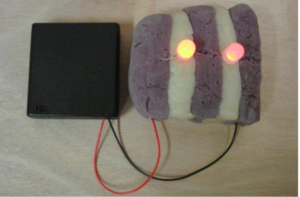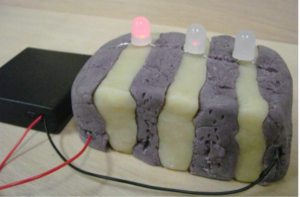Why are we doing this?
Show examples ask about what type of circuit?
LESSON:
Squishy Circuits taught us a lot about circuits but hid a lot of what is going on. Over the next few weeks we will learn more as we move toward our final “flashlight” project . Our final project will be to make a flashlight from a common house hold item. (show electronics projects).
Series Circuit
Squishy circuits did not provide away for us to Measuring Voltage think “how much power is in my battery” Why is this important? Because it lets you know how much time you have to read under the covers before my battery runs out!
Beyond the battery tester. You may have used a battery tester in the past and they say good or bad, but I want MORE info. Show battery tester and battery
The battery tester is measuring voltage. Voltage is used to provide power (via a battery or wall plug) Direct current voltage is what comes out of batteries. For Squishy circuits we used a 9V.
Today we are going to use 3 V Lithium batteries. Voltage is always measured between two points on your battery + and –
Get into the right mode for your multimeter to measure DC voltage/battery look for one dashed and one solid (DC). And set it higher then what you think your battery is going to show. So for a 3V or 9V set it to 20V make sure black sensor is plugged into COM an red sensor is V •Ω•mA•Temp
Test a 3 V battery and 9V
ACTIVITY: Today we gave a new set of CircuitSeriesv4. Read the instructions on the card and complete the challenge. Fill out the ElectricChallengesSeriesCircuitcheckoff.
**Equipment used : Electronic Projects to show, 1 battery tester, 4 batteries some good some bad.1 multi meter per 3 students, Challenges parallel vs Serial equipment.


